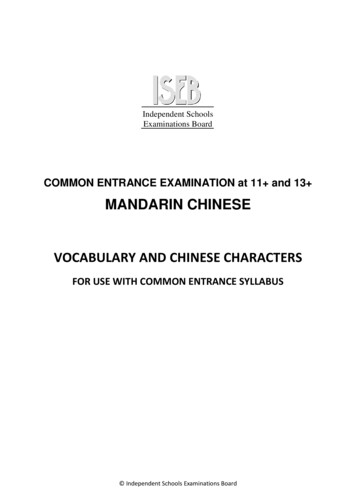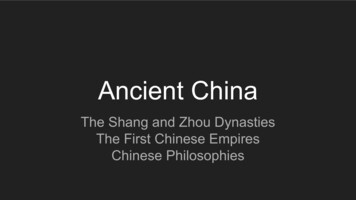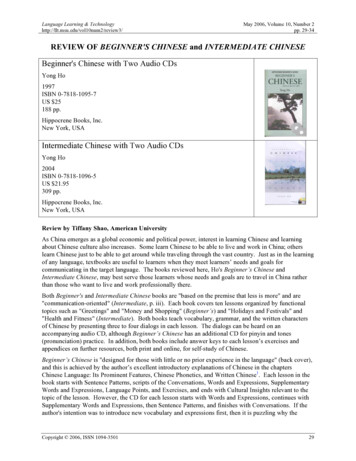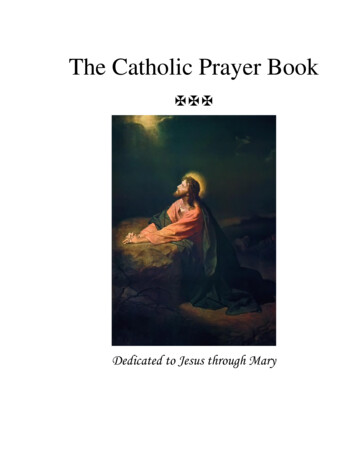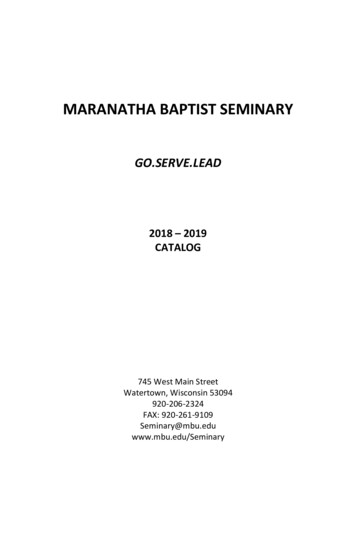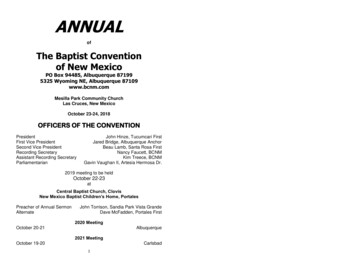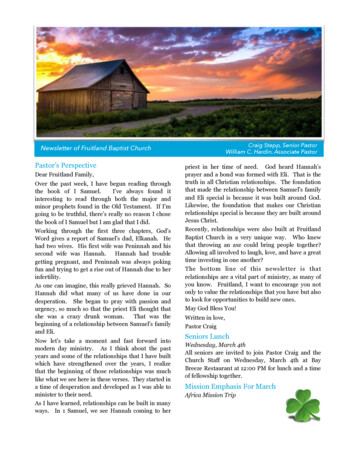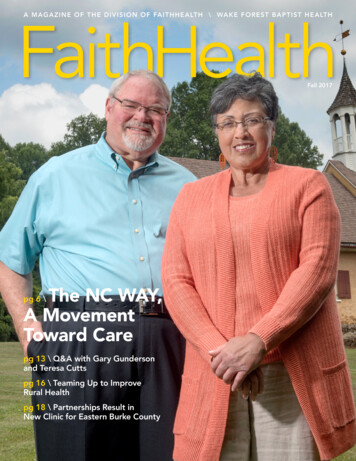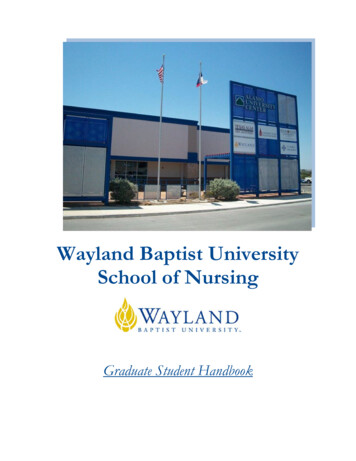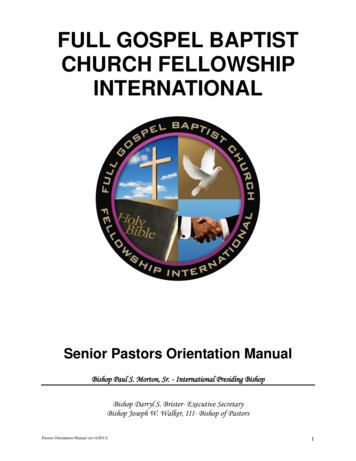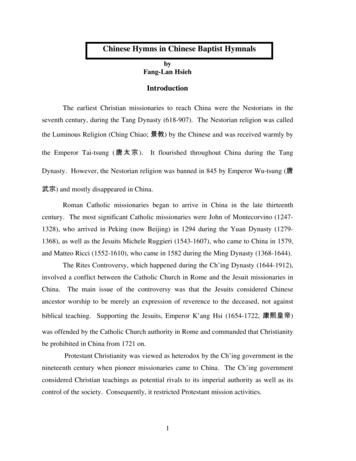
Transcription
Chinese Hymns in Chinese Baptist HymnalsbyFang-Lan HsiehIntroductionThe earliest Christian missionaries to reach China were the Nestorians in theseventh century, during the Tang Dynasty (618-907). The Nestorian religion was calledthe Luminous Religion (Ching Chiao; 景教) by the Chinese and was received warmly bythe Emperor Tai-tsung ( 唐 太 宗 ).It flourished throughout China during the TangDynasty. However, the Nestorian religion was banned in 845 by Emperor Wu-tsung (唐武宗) and mostly disappeared in China.Roman Catholic missionaries began to arrive in China in the late thirteenthcentury. The most significant Catholic missionaries were John of Montecorvino (12471328), who arrived in Peking (now Beijing) in 1294 during the Yuan Dynasty (12791368), as well as the Jesuits Michele Ruggieri (1543-1607), who came to China in 1579,and Matteo Ricci (1552-1610), who came in 1582 during the Ming Dynasty (1368-1644).The Rites Controversy, which happened during the Ch’ing Dynasty (1644-1912),involved a conflict between the Catholic Church in Rome and the Jesuit missionaries inChina.The main issue of the controversy was that the Jesuits considered Chineseancestor worship to be merely an expression of reverence to the deceased, not againstbiblical teaching. Supporting the Jesuits, Emperor K’ang Hsi (1654-1722, 康熙皇帝)was offended by the Catholic Church authority in Rome and commanded that Christianitybe prohibited in China from 1721 on.Protestant Christianity was viewed as heterodox by the Ch’ing government in thenineteenth century when pioneer missionaries came to China. The Ch’ing governmentconsidered Christian teachings as potential rivals to its imperial authority as well as itscontrol of the society. Consequently, it restricted Protestant mission activities.1
Since the early Protestant missionaries were not permitted to preach, theyconcentrated on the planning of mission work, language study, translating Scripture intoChinese, and writing Christian tracts in Chinese.Robert MorrisonRobert Morrison (1782-1834, Chinese name 馬禮遜) was the first Protestantmissionary to reside in China.He arrived in Canton ( 廣 州 ) in 1807 under theappointment of the London Missionary Society. After arriving in Canton, Morrisonimmersed himself in Chinese culture and language. He managed to learn not only tospeak Cantonese and Mandarin but also to write in Chinese.Morrison was a prolific author who translated several books of the Bible andwrote Christian tracts in Chinese. He also translated the Book of Common Prayer intoChinese. Most significantly, Morrison translated hymns and published a Chinese hymnbook titled Sacred Odes to Nourish the Mind (Yang Sin Shen She; 養心神詩) in 1818. Itwas the first hymnal printed in the Chinese language. This words-only hymn book oftwenty-seven leaves contained thirty translations of Psalms and hymns commonly used inEngland, including translations of metrical psalms from the Scottish Psalter, IsaacWatts’s hymns, and the Olney Hymns by William Cowper and John Newton.Morrison and his assistant, Liang Fa ( 梁 發 ), who became the first Chineseevangelist, published a second hymnal called Prayers and Hymns in 1833. The hymnalof sixty pages included English hymns translated into Chinese as well as prayerscomposed by Liang from the Morning Service of the Church of England.Baptist HymnalsOther missionaries were also involved in compiling hymnals, including a fewearly Baptist missionaries – Tarleton Perry Crawford and R. H. Graves.Tarleton Perry CrawfordTarleton Perry Crawford (1821-1902, Chinese name 高第丕) was commissionedby the Foreign Mission Board of the Southern Baptist Convention to be a missionary in2
China. He and his wife arrived in Shanghai in 1852. Later, they moved to the ShandongProvince (山東省) and served fifty years in China.In a letter sent to a missionary C. S. Champness, Mrs. Crawford mentioned thatthere was not a single hymn book in Chinese when they first arrived in Shanghai. Withthe assistance of his Chinese tutor, Tarleton Crawford compiled a new hymnal in theShanghai dialect called Tsán Shîn She (Hymn Book; 讚神詩) and published it in 1855.After moving to the Shandong Province in 1863, Crawford transliterated the Shanghaihymns into Mandarin. The Mandarin hymnal was printed in 1870.One of Crawford’s hymn texts appears in the 1973 New Songs of Praise(discussed later in the presentation). “Father in Heaven, Eternal God” was written in1901 and paired with the tune FOREST by Aaron Chapin.R. H. GravesR. H. Graves (1833-1912), a Southern Baptist missionary came to Canton in 1856.For a number of years, he was pastor of the Chinese Baptist Church in Canton. When theSouth China Mission and the American Baptist Missionary Union established the ChinaBaptist Publication Society in 1899, Graves was selected as the president.In 1876, he compiled a hymnal titled Songs of Praise to the Lord (Tsan Choo SheChang; 讚主詩章). The hymn book contained two hundred and eighty-six hymns andeight doxologies, including several of Graves’s own translations. The remaining wereselections from other Chinese hymnals with modifications. S. B. Partridge, a missionaryof the American Baptist Missionary Union, once commented that Graves’s hymnal was“a most valuable addition to Chinese church literature.”1Gospel Hymns (福音聖詩), 1903In 1903, the China Baptist Publication Society in Canton issued a hymnal calledGospel Hymns (福音聖詩) in Cantonese. The hymnal had two hundred and ten hymns as1Henry S. Burrage, Baptist Hymn Writers and Their Hymns (Portland, ME: Brown Thurston &Co., 1888), 613.3
well as three doxologies. The 1921 edition of the hymnal had two hundred and fourteenpieces. The hymnal was well received with over twelve thousand copies printed.Hymns of Praise (頌主詩歌), 1932The North China Baptist Association issued Hymns of Praise (頌主詩歌) in 1932.The hymnal contained three hundred hymns and was published in the Shandong Provincein word, numerical, and music editions. The hymn book was used widely by the Baptistchurches in North China, as mentioned by Mrs. R. T. Bryan (Chinese name 萬施美麗)who wrote: “The selection of hymns has proven very satisfactory to many churches andchapels throughout North and Interior China.”2In 1941, the China Baptist Publication Society in Shanghai compiled a hymnal forthe Baptist churches in China. The hymnal, titled New Hymns of Praise (新頌主詩集),was based on the 1932 hymn book and kept the same numbering, with sixty choruses,some inserted among hymns and some attached at the end of the hymnal. The 1941hymn book was the first attempt of the Baptist churches in China to use the same hymnalnationwide.New Songs of Praise (頌主新歌), 1973In the early 1960s, Chinese Baptists sensed the need to expand and update theNew Hymns of Praise. A hymnal committee was formed in 1961 to embark on the task.However, the compiling and editing of works could not press forward until 1970, whenthe committee finally established a policy that stated that the new hymnal would retainthe same translated hymn texts unless the committee could find better ones.In 1973, the Baptist Press in Hong Kong issued the new hymnal, titled New Songsof Praise (頌主新歌). The hymn book was compiled by a committee whose memberscame from Hong Kong, Taiwan, and Malaysia. It was co-edited by Gabriel Chi (b. 1922,紀哲生) and L. G. McKinney (Chinese name 麥堅理), with assistance from Baptist2Preface, 1941 edition.4
missionaries in Southeast Asia as well as consultants at the Sunday School Board,including the late Dr. William J. Reynolds.Chinese and Taiwanese hymnsThe hymnal contained six hundred and thirty-nine hymns, in addition to eightyone responsive readings and nine indexes. About ten percent of the hymnal consisted ofChinese hymns, including seven hymn texts written by Tzu-chen Chao (1888-1979, 趙紫宸), better known as T. C. Chao. Chao, who graduated from Vanderbilt University, wasa theologian, Christian writer, poet, and educator. He was often called “The Father ofChinese hymnody.”Chao’s text “Golden Breaks the Dawn” (清晨歌, no. 28) was set to the tune LÊP’ING (樂平調; Example 1), meaning “peaceful joy,” which was composed in 1934 byHu Te-ai (胡德愛), a music student at Yenching University (now University of Peking).The text was first translated into English by Mr. & Mrs. Bliss Wiant in 1946 with the firstline “Rise to Greet the Sun.” Another translation was done by Frank Price in 1953 with adifferent first line, “Golden Breaks the Dawn.” The hymn was regarded by Reynolds as“representative of Asian hymnody that has found a place in American hymnals.”3The tune JASMINE set to the text “Sweet and Holy Jesus’ Name,” is a popularChinese folk song, known as Mo-li-hua (Jasmine; 茉莉花, Example 2). The text of thetwo stanzas was written by Chauncey Goodrich (1836-1925, Chinese name 富 善 ),describing Jesus as fresher and sweeter than any exotic flower. The melody was used byGiacomo Puccini in his opera Turandot (1926) as a motif to represent the ChinesePrincess.Also noteworthy was a hymn tune titled TOA-SIA (大社, Example 3) appearsthree times in the Baptist hymnal (nos. 78, 483, 606), each with a different text. TOASIA, named after a small town in Taiwan, is one of the Taiwanese tunes that I-to Loh (b.3William J. Reynolds and Milburn Price, A Survey of Christian Hymnody, 4th ed. (Carol Stream,IL: Hope Pub. Co., 1999), 132.5
1936, 駱維道) collected from aboriginal tribes. The text of “The True God Made Heavenand Earth” was translated by Goodrich from a Western source in 1852. The hymn wasfirst included in the 1964 Taiwanese hymn book Sèng-Si (Hymns; 聖詩) and later alsoappeared in several Chinese and American hymnals.Twenty-First Century Chinese HymnalsThree hymnals were issued in the first decade of the twenty-first century. CenturyPraise was issued by the Chinese Baptist Press in Hong Kong in 2001, the ecumenicalHymns of Universal Praise by the Chinese Christian Literature Council Ltd. in HongKong in 2006, and Sèng-Si by the Presbyterian Church in Taiwan in summer 2009.Century Praise (世紀頌讚), 2001The Chinese Baptist Press in Hong Kong printed a new hymnal at the turn of thecentury called Century Praise (世紀頌讚). Richard R. Lin (b. 1925, 凌忍揚) was thechief editor, Philip Chan (陳康) the associate chief editor, and Samuel Y. C. Tang (b.1925, 唐佑之), the theology and doctrine reviewer. Several hymnologists, pastors, andchurch musicians were involved as hymnal consultants, including Baptists from Americasuch as Donald Hustad and Terry W. York.Aspiring to cover a wide range of musical styles and textual forms, the hymnal isa comprehensive and up-to-date collection of hymns and Christian songs. It totals fivehundred and seventy-three items, including Western and Chinese hymns, gospel songs,contemporary hymns, and contemporary praise and worship songs.Hymns by BaptistsThe 1975 and 1991 Baptist hymnals served, more or less, as models for the newChinese Baptist hymnal. Several hymns in both hymnals were translated and included inCentury Praise.Hymns for BaptismIn line with its denominational identity, the hymnal included ten items under thecategory Baptism and Witness (nos. 510-19). In those hymns, the words “baptismal,”6
“baptized,” and “baptism” were translated as “jinn” (浸), which literally means “baptizedby immersion,” in contrast to other Chinese words used in other hymnals.Chinese hymns and tunesIncluded in the hymn book was a tune called WEN-TI (聞笛, Example 4). It wasnot based on a traditional Chinese melody, but a song composed by Li Pao-chen (19071979, 李抱枕), a Chinese composer and conductor who received his music educationfrom Oberlin College and Columbia University. The pentatonic tune was set to a textadapted from Psalm 29:11 called “May the Lord, Mighty God” (no. 566). The hymn wasalso selected in several English hymn books, including The Worshiping Church.The hymnal also included a few new hymns and tunes written by contemporaryChinese Christians. Contemporary Chinese hymn writers often faced the challenge ofwriting new Chinese hymn tunes which were not based on pentatonic scales or Chinesefolk melodies and yet remained true to the national identity. Some Chinese churchmusicians made an effort to write hymns that sounded both fresh and familiar to ChineseChristians.Cainan K. M. Mui (梅廣文), the Dean of the School of Music at Singapore BibleCollege, had four hymns in the hymnal, including a tune named CALVARDEN set to atext by a Chinese theologian in Hong Kong Stephen Chan (陳賢一) titled “Children ofGod, How Blessed You Are,” which has a version for mixed chorus and is often sung byChinese choirs. The tune with triplets and rhythmic alternations between triple and duplemeters beautifully reflects the natural accents of the text, which is based on Romans 8:1617.ConclusionA Chinese hymnal, just as a Western one, “reflects to one degree or another wherethe church is and where it is moving.” 4 Chinese hymnody began with twenty-sevenleaves of hymns translated from Western sources by Robert Morrison in 1818 and4Beth Bergeron Folkemer, “Reflections on the Hymnody in ELW,” Dialog: A Journal ofTheology 47 (Summer 2008): 178.7
developed into the three major hymnals published in the first decade of the twenty-firstcentury, each compiled and edited by Chinese Christians.Hymn TunesEarly Chinese hymn tunes were mostly taken from Chinese traditional and folkmelodies and arranged in a four-part harmonic style resembling that of Western hymns.In the later part of the twentieth century, however, hymn arrangers began to set hymns indistinctive Chinese styles, some with tunes in unison and accompanied by sparse chords.Hymn TextsIn regard to hymn text translation, hymnal compilers during the missionary eratranslated hymn texts in the particular dialect their congregations understood. In the1930s, a few Chinese Christians fluent in both Chinese and English began to translatehymn texts. Usually they carefully followed the Chinese classical poetic style in wordingand rhyme scheme.Since the mid-twentieth century, hymnal compilers have paid g
Chinese folk song, known as Mo-li-hua (Jasmine; 茉莉花, Example 2). The text of the two stanzas was written by Chauncey Goodrich (1836-1925, Chinese name富善), describing Jesus as fresher and sweeter than any exotic flower. The melody was used by Giacomo Puccini in his opera Turandot (1926) as a motif to represent the Chinese Princess.

